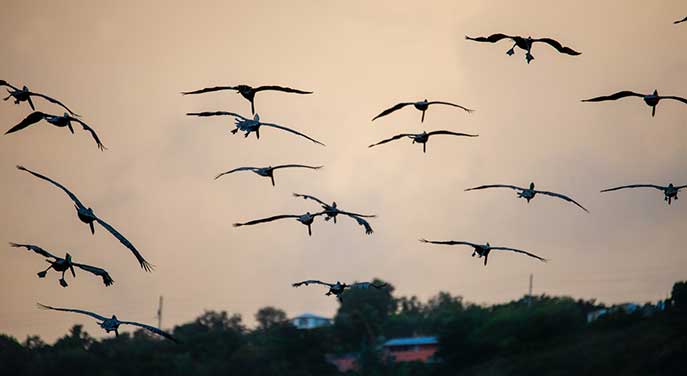 I get both excited and saddened at this time of year. In the spring, I await the return of the birds and then all summer long I enjoy their song, but in the fall I know they will soon be migrating south. The young have fledged and the adult birds have put on enough weight to start the journey. Many of the smaller birds will lose eight to 15 per cent of their body weight daily just so they can get to their winter homes!
I get both excited and saddened at this time of year. In the spring, I await the return of the birds and then all summer long I enjoy their song, but in the fall I know they will soon be migrating south. The young have fledged and the adult birds have put on enough weight to start the journey. Many of the smaller birds will lose eight to 15 per cent of their body weight daily just so they can get to their winter homes!
Birds migrate to survive the winter, not so much to escape the cold but rather to find enough food to survive. Unless you eat fruits or seeds, food is pretty scarce come November and beyond. So there is no choice but to leave.
We sometimes see some specular exoduses. Hawks fly through by the tens of thousands on certain days when the weather conditions are perfect. In mid-September the star of the show is the Broad-winged Hawk. It is one of the few species in North America that migrates in flocks. At this time of year thousands moved out of Ontario in large swirling flocks barely visible against the beautiful clear blue skies. They form what are called kettles, which are simply a large number of hawks that use rising air currents called thermals to stay aloft. This makes their migration almost effortless as they will travel to Central and South America to overwinter. Other hawks go through singly, but over the course of a day you might see several hundred birds of 10 or more species.
 |
| Related Stories |
| Monarch butterflies here today, gone tomorrow
|
| Canada Jay is the best choice to be our national bird
|
| Smart drone technology helping protect birds from industrial hazards |
Smaller birds, called passerines or perching birds, such as warblers, finches and flycatchers, move mainly under the cover of darkness in an attempt to hide from predators that hunt them en route. Recently a massive movement of birds – involving tens of thousands of birds from all over Ontario, among them warblers, sparrows, thrushes, and vireos – occurred near my home in Ontario. In the pre-dawn light, one could hear their plaintive ‘peeps’ and soft whistles as they ‘spoke’ to each other.
Night-time communication between birds in the mixed flocks seems essential, but exactly why is unclear. Perhaps they simply need the ‘way to go guys’ support of their peers to help them along this arduous journey? Or perhaps the sounds of their “buddies” help guide flocks through the pitch darkness so they can find their way?
Regardless, come dawn, they arrive at the place where they will start their day. They will feed frenziedly for a couple of hours on whatever bugs they can find. Vocalizations are uttered to ensure flock integrity, to warn of predators and to announce where food can be found in abundance as they have to replace the weight they lost overnight. Suddenly, however, all activity seems to stop and the hundreds of birds simply disappear for much of the day. But where did they go?
Once they have fed, the migrants need to find a safe place to sleep. They have likely been flying all night and travelling hundreds of kilometres – so rest is essential. Late in the day, there is a new flurry of activity as they awaken and resume feeding in preparation for the next night’s migratory flight. And so it continues until they eventually reach their tropical winter homes.
As we see such a tiny part of this spectacle, it’s hard to imagine the scope and magnitude. One thing that ensures the success of this journey is an incredible correlation in timing between the migrating birds and food sources available along the way. Most migrants feed on insects, so the bugs have to be present in abundance – and when nature is in balance, the birds will be as well. If that balance is disturbed, these tiny migrants can’t find food they will perish. Fingers crossed for a safe journey!
Geoff Carpentier is a published author, expedition guide and environmental consultant. Visit Geoff on LinkedIn, Instagram and Facebook.
For interview requests, click here.
The opinions expressed by our columnists and contributors are theirs alone and do not inherently or expressly reflect the views of our publication.
© Troy Media
Troy Media is an editorial content provider to media outlets and its own hosted community news outlets across Canada.


